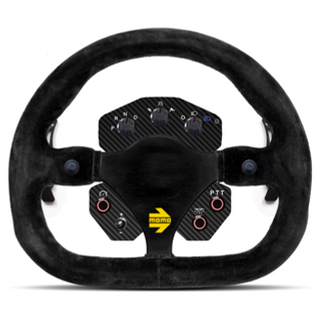SR7 Steering Wheel
- Oliver Wan
- Mar 1
- 4 min read
Updated: Apr 7

Project Overview
Redesign and manufacture of the steering wheel of Sunswift Racing's SR7 race car for use in the Bridgestone World Solar Challenge.
My Role:
This project was the very first project I worked on when I joined Sunswift Racing. As the project lead, I was responsible for the industrial design / physical housing design, interface design, usability testing and manufacture. I collaborated with embedded systems engineers, who were responsible for the printed circuit board design and wiring.
Tools:
Procreate, Cardboard Prototyping, SolidWorks, Keyshot, Laser cutter, Waterjet cutter, FDM 3D Printer
The Problem:
A steering wheel had already been designed and built, but its design was poor - the toggles were unnecessarily large, the walls were flimsy, the labelling was cheap, the interface was not user-friendly, the wiring was a mess, the internal space utilisation was ineffecient, the components used were unreliable, and the overall structure was unsightly.
Stage 1: Empathise and Define:
I started by interviewing key stakeholders to understand the problem and the requirements in more detail.
Aesthetics:
I started by interviewing the Team Principal, Richard Hopkins, to develop an understanding of the ideal aesthetic for the design.
The prompt was to design a steering wheel that resembled the utilitarian, high performance aesthetic of a Formula One Steering Wheel. The only requirement was that the original Momo steering wheel must be retained - and a controlled housing should be designed to integrate with this steering wheel.
From this, an inspiration board was created.
Understanding Component selection requirements
By speaking with the technical manager of the team, I was able to understand constraints surrounding component selection - what controls were required, what components to avoid, what wiring connections to use, etc. Ultimately, the goal was to maintain the same set of controls but select a more visually consistent and reliable set of physical switches.
Empathising with users:
By interviewing race drivers and race engineers, I was able to understand pain points experienced with the current steering wheel. These stakeholders emphasised the importance of tactile operability (without taking eyes off the road), universally intuitive button labels, ease of disassembly and maintenance and most importantly, reliability of all systems.
Stage 2: Ideate and Prototype
Button layout and ergonomics testing
I figured to create a quick and dirty protype using thumbtacks and cardboard, as this allows for the fastest mode of iterating button layouts. I would create a proposed button layout, get feedback on visual symmetry and test that people of various hand sizes could reach all switches comfortably. By taking photos of people's hands, I was able to take digital to-scale measurements to guide the 3D modelling process.
3D Modelling
By taking physical measurements of the Momo wheel, hole layout, mounting hub and anthropometrics measurements, I was able to produce the first version of the steering wheel 3D model. The goal here was to ideate different ways of fastening parts together and packaging internal electrical components efficiently.
Designing intuitive button labelling
Given that SR7 will be driven by various members of the SR team (each of which having a different level of familiarity with cars) and external stakeholders - such as news media, the symbols used to communicate the purpose of each switch on the steering wheel should be intuitive to a large audience. To optimise this, I created multiple variations for icons for each button and interviewed people to ask which one they would press if the wanted to perform a given function.

Ideation of and testing of aesthetic variations
When designing a million-dollar car with strong international media exposure, it becomes essential to ensure that the industrial design of the steering wheel is aesthetically pleasing.
To quickly produce multiple high fidelity aesthetic variations, I used photoshop to very quickly create somewhat realistic mockups.
Stage 3: Test, Iterate, Repeat
At this stage, with electrical components selected, a structural shape defined and materials chosen, I began the tedious process of thinking through the finer details - how are things fastened together? How will the PCB be mounted? How will the hinge mechanism work? How will I ensure ease of assembly and wiring? It was a tedious process involving many small prototypes, failures and iterations. However, by making small, cheap and quick prototypes to test assumptions, I was able to quickly converge on the optimal solution.
The Outcome
Eventually, I handed over the project to the embedded systems team and through many track day tests, software bug fixes, and a couple of loose wires, the steering wheel gradually became more and more reliable until one day, it simply did its job. We got the steering wheel to the point where the car could perform rural inter-state driving for thousands of kilometres without an issue. In 2023, we entered the Bridgestone World Solar Challenge - an international race from Darwin to Adelaide with 40 universities competing. The steering wheel performed reliably and we won!













































